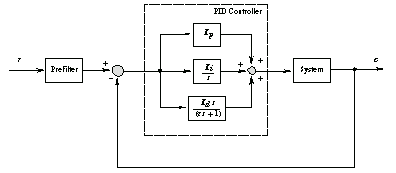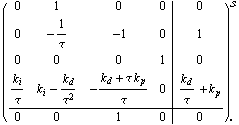|
6.5 Using Interconnecting Functions for Controller Design
Due to their symbolic capabilities, the interconnecting functions described in this chapter can be especially useful for design purposes. In a typical scenario, the designer chooses the structure of the controller and then determines the particular values of its parameters to meet the specifications. Several design functions are described in details later in Chapters 9 and 10. The example given here illustrates that the ready-made set of design tools can be easily expanded and outlines possible steps in that process.
We consider a double-integrator model of the satellite control system and design a PID (proportional-integral-derivative) controller that would place the poles of the closed-loop system in some predefined positions (cf. Section 9.1). The block diagram of a PID controller connected to the system is shown in Figure 6.9. Only the propagation of the reference signal r to the controlled output c is taken into account. A typical system would also have a disturbance input, not shown on the diagram. The prefilter can be used to further correct the dynamics of the system, for example, by eliminating unwanted zeros from the closed-loop transfer function. Note that the derivative part of the controller includes the term  , with a presumably small time constant , with a presumably small time constant  . Otherwise that part would not be physically realizable. . Otherwise that part would not be physically realizable.

Figure 6.9. PID controller example.
Here is a double integrator plant.
In[50]:=
Out[50]=
This describes the PID controller.
In[51]:=
Out[51]=
This connects the controller to the plant, closes the feedback loop, and simplifies the result.
In[52]:=
Out[52]=
This finds the transfer function of the closed-loop system.
In[53]:=
Out[53]=
Here is the denominator of the transfer function as a polynomial in the variable s.
In[54]:=
Out[54]=
This makes the polynomial monic.
In[55]:=
Out[55]=
Suppose now that the closed-loop system with desired dynamics has poles at  , ,  , ,  , and , and  . This is the denominator of the corresponding transfer function. . This is the denominator of the corresponding transfer function.
In[56]:=
Out[56]=
To find the unknown parameters  , ,  , ,  , and , and  we equate the coefficients of powers of s in the denominators and solve the resultant system of equations. we equate the coefficients of powers of s in the denominators and solve the resultant system of equations.
In[57]:=
Out[57]=
This is a simplified result for negligible  . .
In[58]:=
Out[58]=
|